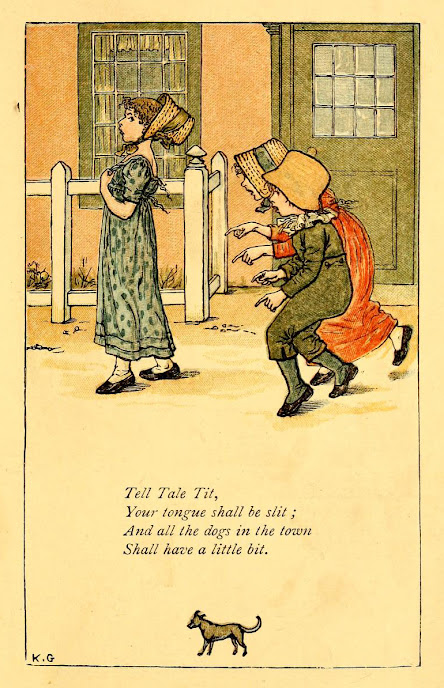Kate Greenaway (Catherine Greenaway) (1846-1901) was a children's book illustrator and writer. Her first book, Under the Window (1879), a collection of simple, perfectly idyllic verses concerning children who endlessly gathered posies, untouched by the Industrial Revolution, was a best-seller. The Kate Greenaway Medal, established in her honour in 1955, is awarded annually by the Chartered Institute of Library and Information Professionals in the UK to an illustrator of children's books. New techniques of photolithography enabled her delicate watercolours to be reproduced. Through the 1880s and 90s, in popularity her only rivals in the field of children's book illustration were Walter Crane and Randolph Caldecott, himself also the eponym of a highly-regarded prize medal.Part 3 of a 13-part series on the works of Kate Greenaway.
For more biographical information see part 1, and for earlier works see parts 2 & 3 also.
1881 Mother Goose (or the Old Nursery Rhymes):
 |
| Front Cover |
 |
| Copyright page vignette |
 |
| Title Page |
 |
| Frontispiece |
 |
| Publisher |
 |
| Vignette |
 |
| Dedication |
 |
| Vignette |
 |
| Hark! Hark! the dogs bark, |
 |
| Little Jack Horner sat in a corner, |
 |
| There was an old woman |
 |
| Diddlty, diddlty, dumply |
 |
| We're all jolly boys, and we'er coming with a noise |
 |
| To market, to market, to buy a plum cake, |
 |
| Elsie Marley has grown so fine, |
 |
| Daffy-down-dilly has come up to town, |
 |
| Jack Sprat could eat no fat. |
 |
| Lucy Locket, lost her pocket, |
 |
| Cross Patch, lift the latch, |
 |
| Johnny shall have a new bonnet, |
 |
| There was a little boy and a little girl |
 |
| Draw a pail of water, |
 |
Jack and Jill
|
 |
| Little Bo-peep has lost her sheep, |
 |
| Polly put the kettle on, |
 |
| Little Tommy Tittlemouse, |
 |
| Tell Tale Tit, |
 |
| Goosey, goosey, gander, |
 |
| Willy boy, Willy boy, where are you going? |
 |
| Mary, Mary, quite contrary, |
 |
| Bonny lass, pretty lass, wilt thou be mine? |
 |
| A dillar, a dollar, |
 |
| Little Betty Blue, |
 |
| Billy boy blue, come blow me your horn, |
 |
| Girls and boys come out to play, |
 |
| Here am I, little jumping Joan, |
 |
| Ride a cock-horse, |
 |
| Rock-a-bye baby, |
 |
| Little Tom Tucker, |
 |
| Little Miss Muffet, |
 |
| Humpty Dumpty sat on a wall, |
 |
| See-Saw-Jack in the hedge, |
 |
| Little lad, little lad, |
 |
| As I was going up Pippin Hill, |
 |
| Little maid, little maid. |
 |
| My mother, and your mother, |
 |
| All around the green gravel. |
 |
| One foot up, the other foot down, |
 |
| Georgie Peorgie, pudding and pie, |
 |
| As Tommy Snooks, and Bessie Brooks |
 |
| Tom, Tom, the piper's son, |
 |
| Ring-a-ring-a-roses, |
 |
| End piece |




















































